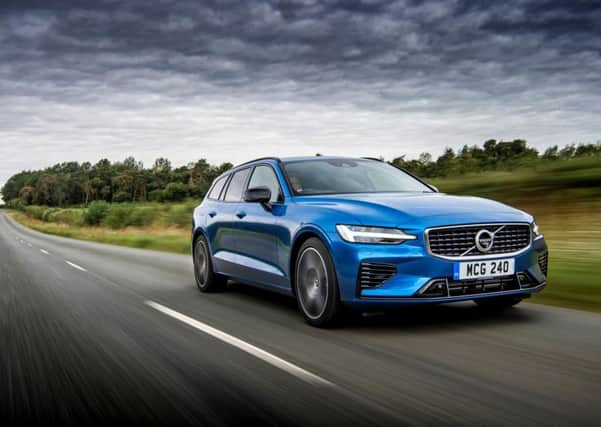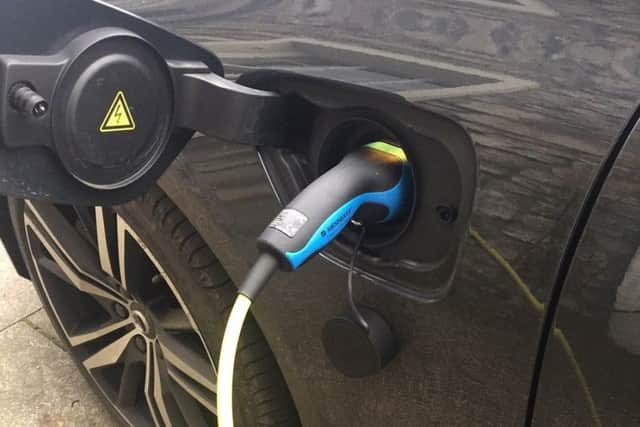Review: Volvo V60 T8 Twin Engine AWD Automatic R Design Plus


Seat belts date from the early 1800s, when the wealthy Yorkshire flying pioneer, Sir George Cayley, fitted one in his glider – itself a world first. Saab and Volvo pioneered the car lap belt in Europe in the late 1950s. Some cars in America had lap belts but it was Volvo which made them standard fit from 1959. Volvo patented the three-point belt then made it available to everyone.
The Volvo V60 T8 hybrid left at home would have been slower than the train, quicker than the bus, but would have used hardly any fuel because it has a mains rechargeable hybrid electric petrol engine system. This allows the car to run for 20 miles or more on the battery alone, and at other times on a mix of battery and petrol.
Advertisement
Hide AdAdvertisement
Hide AdThe battery can be charged in a couple of hours through a dedicated fast charger; double that using a domestic three-pin socket. Braking and deceleration also charge the battery and you can select engine charging of the battery on the car’s information screen. You achieve electric mileage selecting “pure eco drive”. The default system is “hybrid everyday use” which automatically blends petrol and battery power. Other settings are sport and constant all-wheel-drive.


With this technology now offered on the XC40 compact SUV, Volvo can claim to be the only manufacturer to offer plug-in hybrid electric vehicle charging (PHEV) across all models.
The system produces remarkable power and economy and emission ratings. For example, the XC40 which has a 1.5-litre three-cylinder petrol engine and an electric motor has figures of 258 brake horse power, 0-62mph in 7.3 seconds, up to 141mpg and 38g/km of carbon dioxide. The potential range on solely electric power (and thus no emissions), is 28 miles. Prices start at £40,905 and you can get one next February if you beat the rush. Its ratings bring tax savings for company car drivers plus good daily economy and minimal emissions if you keep the battery charged.
As it happens, though, PHEV sales here are not increasing this year, hit by higher prices for the system and loss of grants. The growth is coming from petrol hybrids, from mild hybrids which give lower amounts of battery power to petrol or diesel engines and from pure electric models. Together they reached a new record of 200,000 sales in the first 10 months. Pure petrol cars took 1.3 million with just over half a million for diesel which is still declining in demand.
From its array of PHEV cars Volvo sent us a V60 – its smart (and very safe) medium-large estate car. You can get a V60 for £34,665 which brings a very acceptable, economical 148 bhp 2-litre diesel rated at 119g. To get a PHEV model you pay from £50,905 for the 385 bhp T8 Twin Engine AWD Automatic tested here. Its official economy is up to 166mpg and with CO2 of 42g has a low 16 per cent benefit in kind tax for company drivers and no annual road tax. It is some £10,000 more than another V60, apart from a 399-bhp Polestar version, which is £57,205 and has alterations to the engine tune, chassis. brakes, forged 19-inch wheels, hi-fi and cosmetics.
The demo car was tricked out with several option packs which lifted the price of £57,255. Items included £1,800 for the panoramic opening roof, an overhead camera view and parking control. Safety was upgraded with £1,625, which included adaptive cruise control which brings the car to a halt, and monitoring and intervention for hazards outside the car such as crossing traffic. The metallic paint was £675 and 19-inch alloys with low-profile tyres added £550.
Those skimpy tyres were a likely cause of vibrations and the firm ride quality at low speed but that is my only mechanical grumble. Focusing on displays showing your battery consumption and potential electric range is distracting. Better just let the car do the thinking. There is voice control but “it” didn’t always comply.
Small but useful details are a ticket clip on the windscreen, a red marker on the speedometer shown the mph zone you are in, a foot rest pad on the rear transmission tunnel, and a flip-up load divider in the boot.
Verdict: Charming but watch its speed.